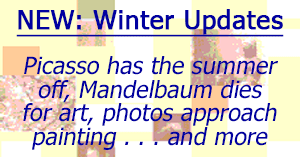Summer is a time for getting out and doing things, when warmth welcomes you outdoors and sunlight tempts you to explore. So they tell you, but my most cherished memory of summer is lying on my back.
I remember myself as a child, my arms spread as if I could float or fly. Maybe you had those moments, too, when the grass to every side reaches up to the sun and the music in your head slows time. Call it dreamlike if you like, but everything in nature and in memory feels that much more real and observed. So it is, too, with Alexis Rockman in a cold New York winter, at Magenta Plains through February 24.
Rockman works in watercolor, a medium long used for precise observation, especially of flowers. As with Charles Burchfield or J. M. W. Turner, it also suits those moments when an observation is also a vision. Rockman relishes the paradox, and the gallery stresses his interest in nature while calling his work dreamlike. I vote for the first. Even in sleep, he could name the flowers to every side and the butterflies above. I took the first at times for mushrooms, from their shape, and the latter for birds, but then I could as well have been tripping or flying.
Rockman takes the perspective of someone looking up to the sky. It places the unseen observer at the center of the work. Not that such an observer lacks in feeling. Flowers seem to lean in, even as the eye insists that they are leaning away. The gallery calls the show “The Toxic Sublime,” but it seems healthy enough to me, and it stays close to the earth. It does not need an ode to a Grecian urn to evoke quiet and slow time.
For all that, everything is in motion, because flowers and insects have work to do. Again the medium helps, fluid and fast drying. So does the necessity of work to all sides without a narrative progression. Tiril Hasselknippe, too, invites one into his art, with sculpture as installation, but he means it as an entryway to a state of mind. He calls the sculpture Hyperstate and the show, which also includes a sketch, Portals. It brings light to a dark room, like the nightmare counterpart to Rockman’s sunlit daydream.
The gallery has settled into an entire building by the entrance to the Manhattan Bridge, like Pace gallery in Chelsea but with less arty neighbors and less costly architecture. On the ground floor, Jane Swavely sets painted verticals into slow motion. Rockman has the floor above, Hasselknippe, who appeared in the 2008 New Museum Triennial, the basement. He could be giving Rockman’s insects new life and translating Swavely’s deep red “zips” into tubes of light. They take the shape of arches or paired legs from a long, thin creature that I would rather not imagine. Either way, they serve as architecture, as company, and as a dream.
Hasselknippe updates light sculpture since Dan Flavin and James Turrell—in LED rather than neon and in PVC sheathed in black mesh. That makes it more flexible and contemporary but also more textured and physical. The arches hang at all heights and no particular intervals. They cluster where they will. They could be a maze without a beginning or end. If this is a nightmare, I am not trying to awake.
